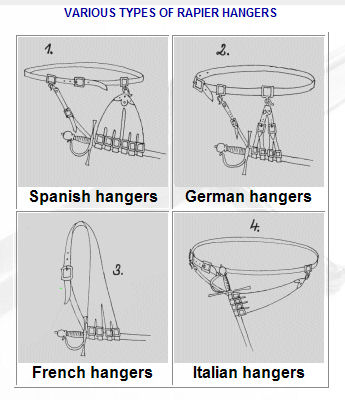| Author |
Message |
|
Dan K. F.
|
 Posted: Mon 21 Jul, 2014 6:52 pm Post subject: Historical rapier hanger styles of the 17th century Posted: Mon 21 Jul, 2014 6:52 pm Post subject: Historical rapier hanger styles of the 17th century |
 |
|
Hi all,
I'm doing some research for a 17th century rapier hanger to match an A&A cavalier rapier and stumbled upon this illustration of different rapier styles on the Lutel website (attached).
Does anyone know what period these styles would be accurate for and whether they would be exclusive to the countries they're named for in the diagram (ie. Spanish-style hangers would only be worn by Spaniards)?
Thanks!
 Attachment: 31.36 KB Attachment: 31.36 KB
![Lutel_rapier_hangers[19].jpg](files/lutel_rapier_hangers19_143.jpg)
|
|
  |
 |
Shahril Dzulkifli

|
 Posted: Fri 15 Aug, 2014 4:10 pm Post subject: Historical rapier hanger styles of the 17th century Posted: Fri 15 Aug, 2014 4:10 pm Post subject: Historical rapier hanger styles of the 17th century |
 |
|

Now I see. So that's how swordsmen in 17th century Europe hang their rapiers, each with their own style.
“You have power over your mind - not outside events. Realize this, and you will find strength”
- Marcus Aurelius
|
|
  |
 |
|
Julian Reynolds
Location: United Kingdom Joined: 30 Mar 2008
Posts: 271
|
 Posted: Sat 16 Aug, 2014 1:34 pm Post subject: Posted: Sat 16 Aug, 2014 1:34 pm Post subject: |
 |
|
This is, as usual, a massive over-simplification.
The rapier girdle (the first of the illustrations) was widely used in countries other than Spain (in Elizabethan England, for instance, Spain's sworn enemy at the time). It is the most 'representative' means of wearing a rapier in the late sixteenth century. (It's also very convenient, as you can unhook your rapier when you want to sit comfortably, because they're awkward things to wear even at the best of times, believe me......).
Baldrics (illustration 3) tend to come later, in the early seventeenth century, but, again, this example is also seen all over Northern Europe (not just France), and features, in various forms, on both sides of the 30 Years War, and on into the English Civil War. It becomes wider and more extravagant (often faced with embroidered fabric) on into the second half of the seventeenth century.
Hope this helps you,
Julian
|
|
  |
 |
|
Jeffrey Faulk
|
 Posted: Sat 16 Aug, 2014 2:21 pm Post subject: Posted: Sat 16 Aug, 2014 2:21 pm Post subject: |
 |
|
This is a case where it's really far more a case of personal choice and fashion than any specific choice one way or another. Your best luck would be to examine image archives of pictures from the area and period to see which one is most predominant.
None of these designs would be particularly 'exclusive'. They might be slightly predominant in one area over others, but that's it.
|
|
  |
 |
|
|

